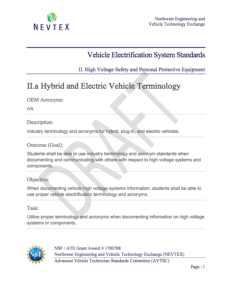Vehicle Electrification Systems Standards: High Voltage Safety and Personal Protective Equipment

Vehicle Electrification Systems Standards Curriculum Description:
The Vehicle Electrification Systems Standards curriculum is provided by the Northwest Engineering and Vehicle Exchange (NEVTEX) and was developed by Central Oregon Community College (COCC) and Rio Hondo College (RHC). COCC and RHC worked together "to develop curriculum and training standards for technicians in hybrid electric vehicle (HEV), electric vehicle (EV), and Fuel Cell (FC) vehicle systems." This curriculum was developed with the intention of addressing industry needs by partnering with industrial and educational representatives to obtain input and assistance to develop:
- new approaches to prepare an advanced technologies workforce,
- licensure procedures and policies to ensure the safety of technicians, their employers, and clients, and
- collaboration between educational and industrial partners in the development of new standards and practices.
The Vehicle Electrification Systems Standards are divided into 11 topics. This section of the standards covers the topic Vehicle Level Vehicle Electrification High Voltage System Architectures. The other 10 topics and a Master Acronym and Definition list are available to view separately.
High Voltage Safety and Personal Protective Equipment Description and Contents:
This section of the Standards includes the following five lesson plan outlines: II.a Hybrid and Electric Vehicle Terminology, II.b High Voltage Wire and Cable, II.c High Voltage Components Labels and Identification, II.d High Voltage Electrical Measurement Equipment, and II.e High Voltage Electrical Gloves In-Service Care and Inspection. The lesson plans include a description, objectives, tools, tasks, and outcomes.
The terminology lesson plan is intended for students to "... utilize proper terminology and acronyms when documenting information on high voltage systems or components."
The high voltage wire and cable lesson plan has students "... locate all high voltage cables on the classroom vehicle and the component connected to them and draw a block diagram of high voltage cables, components, and connections."
The high voltage components lesson plan has students use a classroom vehicle to locate high voltage components and identify the high voltage label.
The high voltage electrical measurement equipment lesson plan has students "... perfor[m] measurements on high voltage systems using voltmeter, oscilloscope, and current clamps that meet the minimum standard safety requirement.
The high voltage electrical gloves lesson plan students "... visually inspect and field test a pair of high voltage gloves and determine if the gloves are compliant with standards guidelines."
About this Resource


Comments